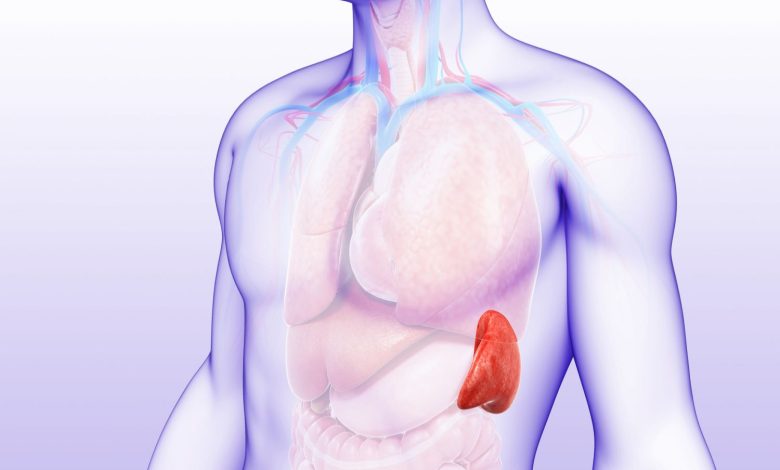Splenomegaly, enlarged spleen: What's it, causes, symptoms, diagnostics, treatment, prevention

Splenomegaly; Spleen enlargement; Enlarged spleen; Spleen swelling
What is splenomegaly?
Splenomegaly is an enlargement of the spleen, which occurs, when an organ increases in size or volume. This is a relatively common condition., which is usually associated with other diseases, such as anemia, cirrhosis of the liver and blood diseases.
The spleen is an organ, subthoracic, on the left side of the body. It helps filter out and destroy infected or damaged red blood cells., and may also play a role in fighting infections. Splenomegaly, or splenomegaly, can have serious health consequences, because it can create an additional burden on other organs, interfere with the body's ability to regulate blood flow and, perhaps, lead to life-threatening infections and anemia.
Causes of splenomegaly
There are many potential causes of splenomegaly, including:
Infectious diseases
- Mononucleosis (Epstein-Barr virus)
- Malaria
- Cytomegalovirus (CMV)
- HIV / AIDS
- Brucellosis
- Tuberculosis
- Typhus
- Chagas disease
- cat scratch disease
- Syphilis
Blood diseases
- Leukemia
- Lymphomas
- Mnozhestvennaya myeloma
- Serpovidnokletochnaya anemia
- Thalassemia
- Polycythemia vera
- Primary amyloidosis
- Lymphoma of the marginal zone of the spleen
- Waldenstrom's macroglobulinemia
Other reasons
- Cirrhosis
- Saint Martin's evil
- Pancreatitis
- Taking certain medications
- Sarkoidoz
- Hypersplenism
- Genetic disease
- Heart or kidney disease
- Diseases of the adrenal glands
- Inflammation of the spleen
Symptoms of splenomegaly
In some cases, symptoms, associated with an enlarged spleen, may be missing, and the condition may go unnoticed. If symptoms do occur, They may include:
- Feeling pressure or pain in the left side of the abdomen or in the area just below the chest
- Fatigue
- Weakness
- Loss of appetite
- Pain in the upper abdomen
- Slight fever
- Dilated veins in the abdomen
- Jaundice
- Cough
- Breathlessness
- Night sweats
When to see a doctor
It is important to contact a healthcare professional, if any of the symptoms are present, mentioned above, or other signs of illness. Besides, it is important to contact a healthcare professional, if the person feels full or has pain in the left side below the chest. This may indicate an enlarged spleen.
Questions, that your doctor may ask
When diagnosing the condition, the doctor may ask the following questions::
- What symptoms are present?
- Are there any risk factors?
- Are there any other diseases?
- What medications do you take?
- Do you have a family history of spleen problems??
- Have you had any recent medical procedures?
- Are there other suspicious signs or symptoms?
Diagnosis of splenomegaly
Diagnosis of an enlarged spleen includes a physical examination, review of medical history and diagnostic tests. The doctor will take into account the patient's history, localization of pain and possible risk factors. In some cases, the doctor may also ask for a blood test or an imaging scan..
Blood tests
Blood tests can be an important diagnostic tool to determine the presence and cause of an enlarged spleen.. Tests, which may be useful in diagnosing, include:
- General blood analysis (CBC)
- blood smear
- Blood cultures
- Enzyme tests
- C-reactive protein (SRB)
- liver enzymes
- Electrophoresis
Medical imaging tests
Imaging tests may also be done to more accurately diagnose the condition.. Scan types, which can be fulfilled, include:
- US
- CT scan
- MRT
- PET scans
Treatment for splenomegaly
Treatment for splenomegaly will depend on the underlying cause.
- In cases, when the cause is an infection, it can be treated with antibiotics or antivirals.
- If the cause is a blood disorder, such as sickle cell anemia, may require medication or a blood transfusion.
- For autoimmune diseases, medications can be used to reduce inflammation.
- In cases, when the cause is a malignant neoplasm, surgery may be required to remove the tumor.
- Strong antibiotics may be required in cases of bacterial infections.
Treatment of splenomegaly at home
For mild cases of splenomegaly, a doctor may recommend home treatment.. This may include:
- Monitoring for any change in symptoms or spleen size.
- Reducing stress, to reduce inflammation.
- Follow an anti-inflammatory diet, rich in fresh fruits, vegetables and whole grains.
- Regular exercise to improve circulation and overall health.
- Get plenty of rest, to help the body recover.
- If you have been diagnosed with an infection, take prescribed antibiotics or medications as directed.
Prevention of splenomegaly
The best way to prevent splenomegaly is to practice good hygiene and avoid contact with infections. Other ways to prevent splenomegaly include:
- Avoid contact with sick people.
- Vaccination against infectious diseases, if recommended.
- Avoid contact with known carriers of infectious diseases.
- Eat a healthy balanced diet.
- Avoid exposure to toxins and chemicals.
- Exercise regularly.
- Reducing stress.
- Avoid smoking, drugs and alcohol.
Splenomegaly is an enlargement of the spleen, which may be caused by infections or other diseases. It is important to seek medical attention, if you experience any symptoms of splenomegaly or if you are at risk of developing it due to an underlying medical condition. Diagnosis is often made with a physical examination and blood tests, and treatment depends on the underlying cause. In mild cases, home treatment may be recommended., such as diet and lifestyle changes. Prevention of splenomegaly is best achieved by maintaining good hygiene and avoiding contact with infections..
Used sources and literature
You PM, Barnard in, Cooperberg PL. Benign and malignant lesions of the spleen. In: Gore RM, Levine MS, eds. Textbook of Gastrointestinal Radiology. 4th ed. Philadelphia, PA: Elsevier Saunders; 2015:chap 105.
You PM, Mathieson JR, Cooperberg PL. The spleen. In: Rumack CM, Levine D, eds. Diagnostic Ultrasound. 5th ed. Philadelphia, PA: Elsevier; 2018:chap 5.
Winter JN. Approach to the patient with lymphadenopathy and splenomegaly. In: Goldman L, Schafer AI, eds. Goldman-Cecil Medicine. 26th ed. Philadelphia, PA: Elsevier; 2020:chap 159.
